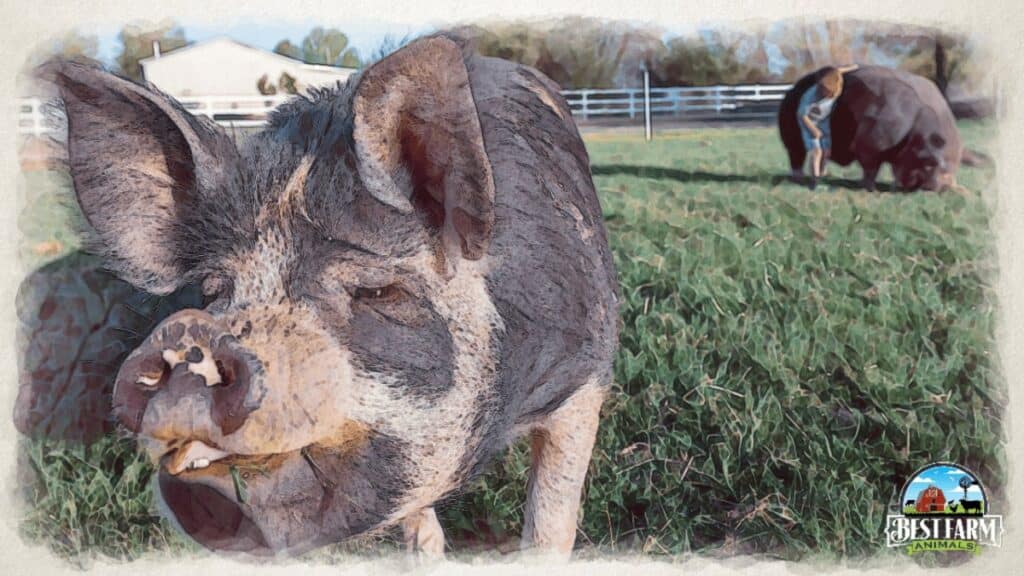Being bullied or attacked by your pet pig is no joke. Even a mini-pig weighs almost as much as the average adult human. Any act of aggression is potentially dangerous. I’ve been bitten and trampled by pigs in the past, and it’s a terrifying and painful experience.
Why is my pig attacking me? Pigs attack their owners because of fear and a lack of trust. Even potbellied pigs or any mini pig can bite its owner to establish dominance, hormonal surges, maternal instincts, or insecurity, or poor training. Additionally, a pig may attack you when it feels uncertain about its place within the herd hierarchy, mishandling, or bad manners.
The video below shows the mishandling in pig aggression, which became a major issue when the pig grew up.
Signs of Aggressive Pig Behavior
The first signs of aggressive behavior usually occur as your pig reaches sexual maturity at around six months. Pigs most commonly direct this aggression towards visitors to the home. This behavior is a normal response, similar to the behavior pigs display when meeting another pig for the first time.
Initially, the aggression will be mild and relatively easy to ignore. The occasional nip of the fingers or a head toss may seem like nothing, but it can quickly escalate.
When a pig tosses or swipes its head, it quickly raises its head and then throws it to one side. In pig body language, this means that they don’t like something about their current situation. They may be telling you they don’t want to be touched or that someone is standing too close to them.
Other signs of pig aggression include biting, teeth chomping, humping, or jumping on people. If your pig charges, nudges, pushes, or grabs at your clothing or shoes, it is being aggressive.
Signs of aggressive pig behavior include:
- Aggression toward newcomers
- Head tossing
- Finger nipping
- Head swiping
- Biting
- Teeth chomping
- Humping
- Jumping
- Charging
- Nudging
- Head butting
- Grabbing at clothes
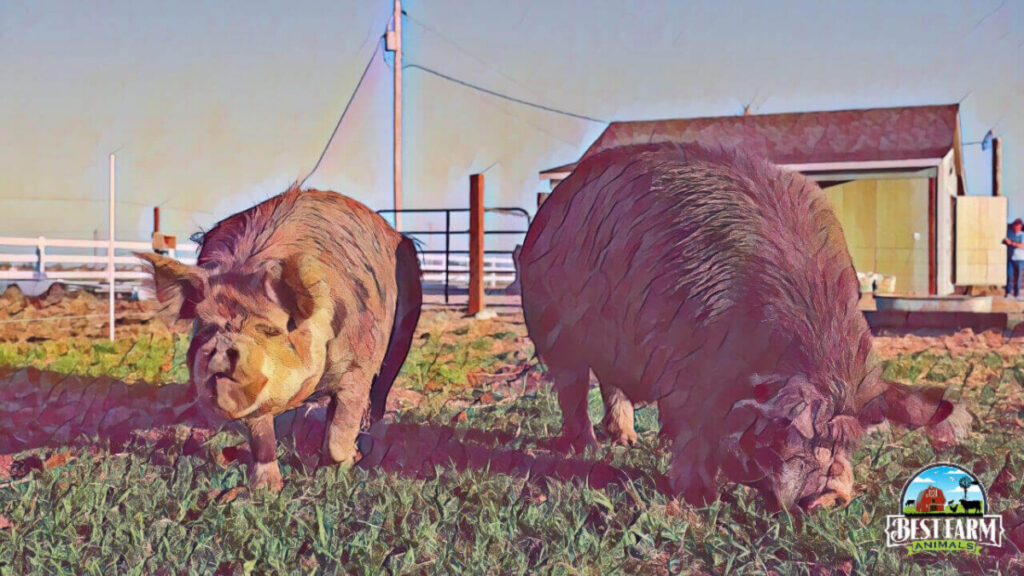
If you tolerate these types of behavior, you’re letting the pig know it’s the leader of your herd. To combat your pig’s aggression, you must establish your dominance and teach your pig that you’re head of the household.
If your pig shows signs of aggression, stand your ground. Don’t shout or cry or run away. Stand still and speak in a calm, authoritative voice. Use a pig board to protect yourself and teach the pig to avoid pressure.
Reasons Pigs Attack People
Pigs show aggression in multiple ways. They may bite, push, nudge, jump up, nip, hump, head butt, or bite the person’s clothing. An aggressive pig may body or head swipe at a person. Jumping up on, humping, or biting the hand with food are other signs of aggression. They may also squeal with high-pitched tones to communicate aggression.
Early signs of aggression include a sideways body posture, a high-pitched tone, and a chomping mouth. If your pig seems aggressive but hasn’t yet bitten, take care to protect yourself as the aggression is likely to increase.
Mature male pigs or sow are the most aggressive pigs. Male pigs are more aggressive because of hormonal surges, but sows are aggressive because of motherly protective instincts.
#1 Pigs Bite When They Are Scared
When you first get your piglet home, it will probably feel a little scared. Pigs are prey animals and defend themselves aggressively if they think they’re in danger. Piglets are tiny, so they don’t have many defenses. Biting is one of the few ways they can protect themselves. Older pigs may continue that behavior.
It’s important to build trust with your pig so that it doesn’t get scared around you. Maintain a calm and steady voice when talking to your pig. Stand still and talk to it. As your pig shows less fear walk into your pigs personal space. This helps to establish your dominance. Pigs are social animals and your pig will want to be around you once it trusts you and sees you as part of its social order.

#2 Pigs Bite to Claim Food Faster
A larger, more confident pig that bites is probably exercising its natural aggression. If you frequently feed a pig by hand, it may become greedy and bite the hand that feeds it. If your pig bites you while feeding it, stop hand feeding immediately. You don’t want to train your pig that it gets treats when biting you.
To train your pig not to bite when eating, feed your pig with a flat palm. Anchor the food in between your fingers. If you pinch the food between your fingers, your pig will likely bite you while trying to get the food.
#3 Pigs Are Aggressive to Establish Dominance
As your pig settles into its new life and sees you as part of its family, it may try to establish dominance within its new herd. It may start to bite when you try to move it or attempt to intimidate other household members by nipping them. Pigs will either see you as the head of the herd or subordinate to them. There is no in-between.
You must be the dominant person in the hierarchy. Do not run from the pig, cry, or show fear. Use a pig board to protect yourself from your pig while you train it not to bite.
#4 Pigs Can Show Aggression Due to Hormones
Pigs also root when sexually aroused. A pig pushing against you and biting you may be trying to alleviate his sexual frustration or instincts. Intact male pigs are most likely to be aggressive due to hormones. If your male pig is constantly aggressive for no reason, you may have to castrate him to alleviate his hormonal aggression.
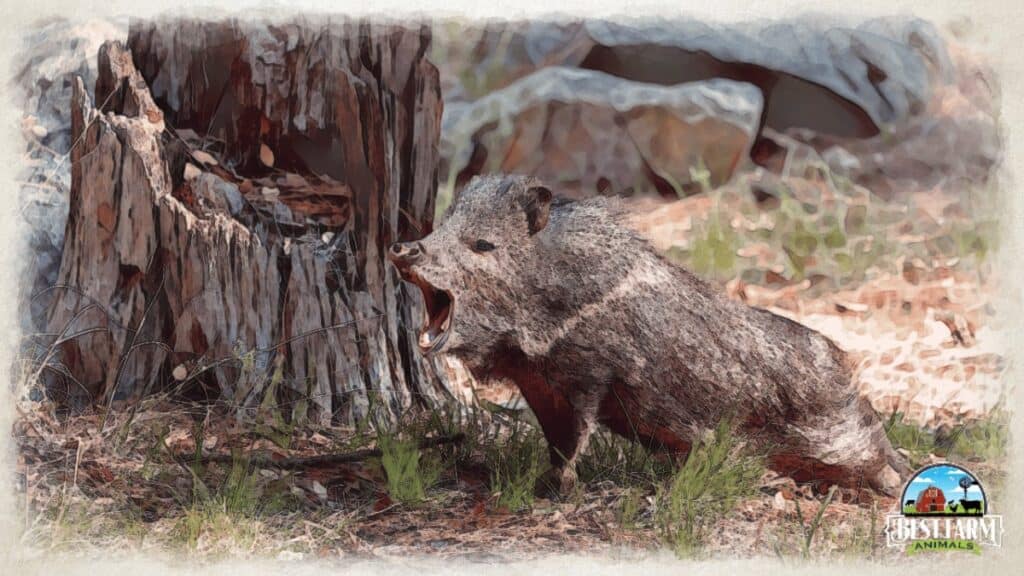
#5 Pigs Become Aggressive When Frustrated or Stressed
Rooting is a natural behavior for a pig. They use it as a form of communication and as a way of finding food. Pigs also cool themselves off by wallowing. Pigs can become stressed, frustrated, and aggressive when they don’t have the opportunity to perform the natural behaviors of mating, rooting for food, and wallowing in cooler areas.
When that happens, nudging stops being a polite form of communication and becomes potentially harmful and dangerous.
#6 Sows May Become Aggressive From Maternal Instinct
When a sow has a litter of piglets, she may become aggressive due to her natural maternal instinct. This can happen if something occurs that makes her see you as a potential danger to her piglets or she doesn’t have a high enough trust level with you. Some pigs can be very gentle, but they turn aggressive when they have a litter of piglets.
Remain aware of the sow when you are inspecting piglets for potential issues so that you can keep safe.
#7 Pigs May Be Aggressive Due to Poor Training (Bad Manners)
Pigs that haven’t been properly trained or shown to respect people may have especially aggressive tendencies from previous handlers. It’s important that you establish your herd dominance and gain the respect of bad-mannered pigs. Do not allow aggression or make the pig fearful.
Never allow piglets or young pigs to show aggressive behaviors even when it doesn’t seem dangerous. Although aggressive behaviors aren’t dangerous initially, they quickly become dangerous as the pig grows.
In older pigs, it can take time to retrain a bad-mannered pig, but it is possible.

#8 Pigs that Jump on You are Trying to Communicate
A pig might jump on its handler out of sheer excitement. Pigs are affectionate animals; if a squeal accompanies the jump, they may just be happy to see you.
If a pig jumps on you while grunting, it could be trying to tell you something. Perhaps he wants more time outside. Maybe he’s experiencing a lack of adequate nutrition or is fearful of something. Each pig communicates differently, and learning your pig’s language takes time. If his posture is erect and his ears pricked before he jumps, it’s more likely to be an act of aggression than pleasure.
When a pig jumps on you but appears happy and relaxed, he’s probably just expressing his happiness. Although jumping may be an act of joy rather than aggression, allowing a 200-lb pig to leap on top of you is never advisable.
Non-Aggressive Reasons Pigs May Root or Nudge Against People
Pigs start rooting and nudging things with their snouts almost as soon as they’re born. Piglets root at their mother’s teat to stimulate her to release milk. Pigs will get comfort from rooting even when weaning, just as a pacifier soothes babies.
Pigs will root for comfort against family members, blankets, and soft furnishings. They may root against you.
As pigs mature, they root for food, and rooting soon becomes synonymous with hunger. A hungry pig might nudge your legs to ask for food, but things have gone too far when those nudges are so hard that they leave bruises.
- Rooting can provide comfort for smaller pigs
- Pigs root when they are hungry
- Pigs root to find food
- Pigs root in wallows to cool off

Understanding the Link Between Aggression and Spoiled Pig Syndrome
A pig that always gets what it wants when it wants it will quickly develop Spoiled Pig Syndrome (SPS). SPS is a common problem amongst pet mini-pigs and potbellies.
Spoiled Pig Syndrome is characterized by the pig becoming overly demanding, often expecting its wants and needs to be catered to immediately. This can lead to aggressive behaviors, such as biting and squealing and destructive behaviors, like chewing or rooting, to get what it wants. Spoiled Pig Syndrome is a behavioral issue that can be addressed with proper training and consistency.
When they arrive in their new home as cute little piglets, their owners overindulge them. Instead of training them, they give them free rein. Inadvertently, these owners teach their little pigs to take whatever food they want and claim the best spot on the sofa.
Unfortunately, indulging a pig in this manner tells it that it’s at the top of the hierarchy. It will then defend that position aggressively.
Pigs naturally live in strict hierarchies where the leader frequently reinforces his dominance. Pigs at the top of the pack are quick to discipline their subordinates, delivering swift, firm punishment for any wrongdoings.
If you don’t assert yourself as the pack’s leader, your pig will. A pig with SPS will expect you to do what he wants and will punish you with a bite if you fail.
Other signs of SPS include:
- Screaming
- Growling
- Snapping
- Charging
- Head swiping
- Snatching food
- Refusing to move when asked
- Destructive behaviors such as ripping up bedding or furniture
Whether or not your pig’s aggression is due to SPS, you need to follow the same steps to correct that unwanted behavior and develop a safe and trusting relationship.

8 Ways to Stop Pigs From Attacking You
How do you make pigs stop attacking you? I’ve done many things before finally discovering what will stop my pig from attacking me. Not all pigs are the same, so here are the eight ways to do it.
Remember, when a pet pig attacks its owner, the owner might be doing something wrong.
#1 Desensitization Can Stop a Piglet Biting
When you first get your piglet home, spend lots of time stroking it and getting it accustomed to being handled.
Sit down with your pig and rub his head when you’ve got a quiet moment. Give him a scratch behind the ears and tickle him under the chin. He’ll lie down or roll over for a belly scratch if he’s anything like my pig.
As soon as your pig relaxes and shows signs of submission, reward him with verbal praise and a treat.
Repeat this frequently during your pig’s first weeks in his new home.
If, at any point, your pig responds aggressively to your touch, stop, but don’t reward his behavior. Wait for him to relax and then start rubbing his head again. Once he accepts your touch, praise, and reward.
#2 Enriching your Pigs’ Environment Encourages Positive Behavior
Pigs are highly intelligent animals that quickly get bored. A pig forced to play with the same toys day after day is likely to tire of the game and may throw a tantrum, much like a toddler would.
You can stimulate your pig by introducing different or new toys on rotation. A novel object stimulates a pig’s natural curiosity, encouraging it to explore and reap the rewards of discovery.
Introducing new toys every few days and keeping a selection of toys on rotation can help stimulate your pig mentally. It will also stop your pig from displaying its boredom or frustration aggressively.
Pigs enjoy a range of toys, from treat dispensers designed for dogs to cardboard boxes and plastic crates.
You can also stimulate your pig’s curiosity by hiding food around the yard or asking him to perform simple tasks to earn his food rewards. For example, you could ask your pig to spin around before giving him a piece of apple. Other basic commands include sit, stay, and bow.
When your pig completes a task successfully, reward him with a treat. This positive reinforcement will stimulate him mentally and establish you as the leader.
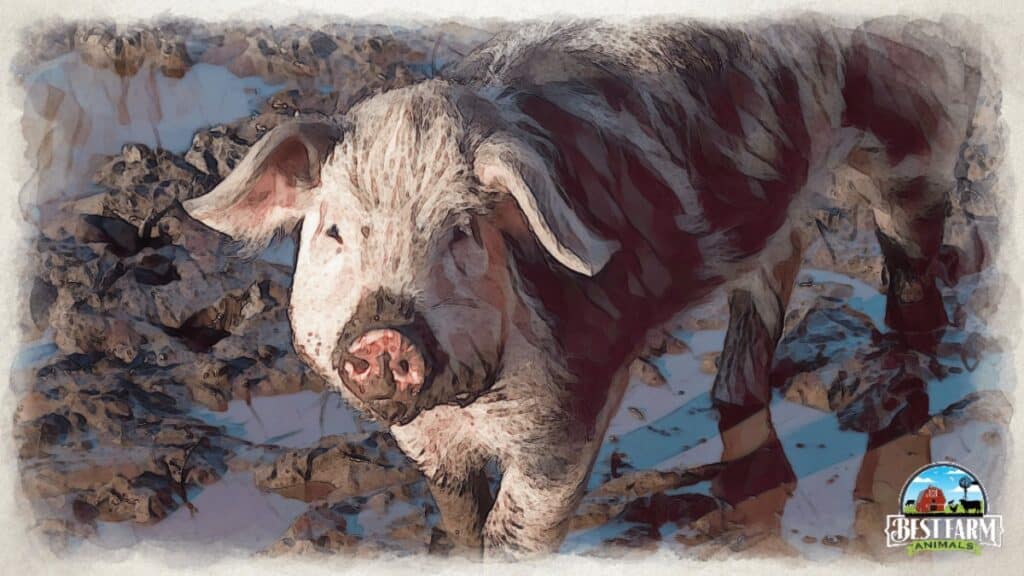
#3 Maintain a Strict Food Regime to Minimize Pig Aggression
A pig that gets a treat every time he nudges your leg will continue to nudge you all day. A pig that only ever receives food at mealtimes or when he completes a simple task will stop nudging you because it fails to elicit the response he’s seeking.
Pigs love food, but they love routine even more. Decide how many meals a day your pig needs. Feeding a pig two to three times a day will keep it well-fed and content.
You can train a greedy pig much as you would a dog. Don’t feed it from the table or out of the kitchen. Don’t share your meals with your pig or give him food off your plate. Make a clear distinction between your food and theirs; your pig will soon learn not to beg or harass you for food.
Our article How To Care For Your Pet Pig, Everything You Need To Know, provides more information on the best dietary regime for your pet pig.
#4 A Pig That Can Behave Naturally will be Less Aggressive
You may have decided that your pig is a house pet, but he still needs opportunities to perform natural behaviors. A pig that keeps nudging at you may need something else for him to root. Giving him a blanket or soft toy to root on will satisfy that need and stop your pig from becoming more aggressive when he roots at you.
Even house pigs need time outside to explore, stretch their legs, and root. A pile of straw in your backyard is an excellent place for a pig to root. You could fill a children’s plastic pool with water to give him a place to wallow and cool off.
Pigs also love mud, so if you don’t mind turning a corner of your garden into a mud pit, drenching an area for your pig to roll in will allow him to perform natural behaviors. This reduces stress and frustration, making your pig happier and less aggressive.
#5 Routine Can Correct Spoiled Pig Syndrome
A pig that’s accustomed to having its own way will benefit from a set routine. Start by keeping your pig out of the kitchen while preparing food. Take him to his bed or mat, ask him to lie down, and reward him for his good behavior.
Similarly, when meal time comes around, ask your pig to move onto his mat, sit, spin, and lie down. Only once he’s completed these tasks can he have his food.
Give your pig a specific bedtime and take him to his bed at the same time every day. Pigs are intelligent and learn new routines very quickly. Once established, they will help your pig feel safe and reduce the signs of aggression.
#6 Positive Reinforcement Encourages Good Pig Behavior
You can’t discipline a pig by hitting, pushing, withholding food, or pulling him around by the ear. This type of behavior will only exacerbate the situation. Your pig will become more fearful of you and may well respond aggressively.
The best way to train a pig is using positive reinforcement. That means rewarding good behavior rather than punishing the bad.
You can start positive reinforcement training as soon as you meet your piglet. Give him a rub on the head and reward him with a small treat. You’ve taught him that he’ll be rewarded if he remains calm and accepts your touch.
You can apply the same approach to almost every situation. When you call your pig’s name, and he comes to you, give him a treat.
Not only will positive reinforcement make it easier to train your pig, but it will also establish you as the leader.
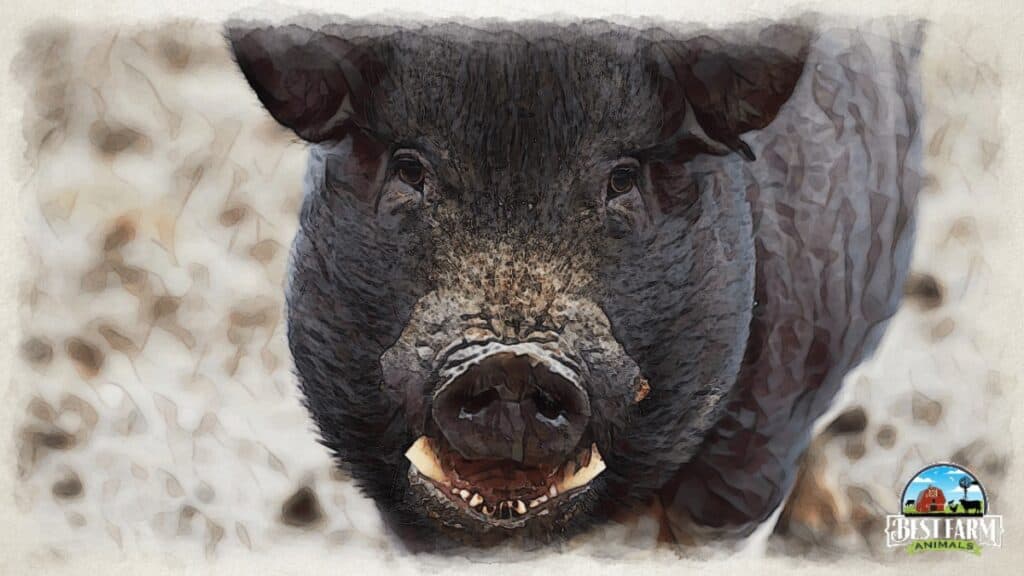
#7 Train Your Pig to Respond Properly
You can train your pig to respect you as the dominant member of the herd by demanding respect. Pigs have a natural bubble of personal space around them.
In the herd, the dominant pig is allowed into the personal space and the subordinate pig will move away. You establish dominance by moving into your pigs bubble and refusing to move. You don’t usually have to touch your pig before it will move away.
If your pig doesn’t move, make a clicking noise and say “move” firmly. Continue to advance until you are against your pig. If the pig pushes against you, apply the same amount of pressure back to the pig. With stubborn pigs, you may need to stomp your feet or waive your arms as you move toward your pig.
Once the pig moves, step back. Stepping back provides the pig a reward for moving away. Stepping into its space establishes the command and dominance, but stepping back teaches the pig that when it moves away, you give it space. This will solidify the behavior of moving away from your pig. You may need to train multiple times a day until your pig has incorporated the behavior. If your pig is very aggressive, bring a pig board (found here on Amazon) to protect yourself from a biting pig and from the husks.
#8 Intact Pigs are More Aggressive and Less Trustworthy
An intact boar is naturally aggressive, especially when he reaches sexual maturity. His instinct is to breed, and he can become frustrated and irritated if he doesn’t have that opportunity.
Boars also tend to have longer tusks that they’re more inclined to use as weapons than sows are. Boars’ tusks also grow faster due to the presence of testosterone.
Although you can train intact males, you’ll find it harder to establish dominance, especially once he’s reached sexual maturity. If you gently nudge a sexually mature boar, he’s liable to see it as a challenge rather than a request and will react accordingly.
Castrating your young pig can help prevent aggressive behavior in the future and make your pig’s life less stressful. A pig with hormones surging through his body can act up and may take out his sexual frustration on you.

How to Show Dominance Over a Pig
The dominant pig in a herd is the one that controls the movements of all the other herd members. Therefore, you need to control your pig’s actions to establish dominance. The easiest and safest way to do this is with a sorting board (On Amazon), especially when dealing with an aggressive pig.
A pig sorting board is a panel you use to block alternative options while moving a pig in the direction you want it to go.
If your pig charges at you, you can use a sorting board to block the charge. Once the pig’s stopped, use the board to ask him to back up. Once he takes a step back, reward him with a treat.
In most instances, it takes little more than gentle fingertip pressure to get a pig to move. A sorting board protects you rather than push the pig around. It stops the pig from charging, jumping, or biting at you as you establish your dominance.
Once your pig responds to the pressure of a sorting board, you can start using more subtle cues. These can include vocal instructions like “come,” “stay,” or “leave,” as well as assertive body language and hand clapping.
A pig that yields to pressure accepts you as the leader and is unlikely to respond aggressively as he recognizes his subordinate position within the herd.
Move the Pig Technique
The Move the Pig technique is used to help you move a stubborn pig in the desired direction. It includes using feed, vocal commands, and the pig sorting board to help the pig move. The sorting board proves effective for aggressive breeds of pigs because it helps protect you and prevents you from getting hurt if the pig eventually attacks.
Note that the pig should be rewarded for moving in the desired direction, such as with food or praise. You could try it out with your pig in a calm environment where it is relaxed to achieve better results. The steps include:
1. Gather the necessary supplies for moving the pig— food and a pig sorting board to protect yourself from attack.
2. Approach the pig in a calm, authoritative and gentle manner. You could clap your hands softly and say, “Come on, Let’s go”
3.If the pig is still unresponsive, use vocal commands such as “Come, boy!” or “Let’s go!” to direct it. You don’t have to shout or yell, but encourage the pig to avoid being frightened.
4. If the pig still does not move, gently guide it in the right direction with physical contact using the pig sorting panels/pig sorting board/pig hurdle.
6. You need to be a bit more authoritative when handling dominant, aggressive or spoiled Pig Breeds. Bump into them repeatedly with the sorting board in your hands, and make your stance clear that you need them to move.
5. Praise the pig and reward it with food or a treat when it completes the desired action.

Aggressive Pig Breeds
Aggressive pig breeds are a select group of pig breeds that have been bred to produce pigs with more aggressive tendencies. Aggression in pigs can range from mild to extreme, depending on the breed and the individual pig.
These breeds are typically used for protection, guard duty, and for some, even as a form of entertainment. Aggression is often inherited, but proper care and training can help manage the animal’s behavior and reduce the chances of it becoming overly aggressive.
For people with the right experience and dedication, aggressive pig breeds can make for loyal and loving companions.
Some examples of aggressive pig breeds are:
| Pig Breeds | How This Pig Breed Shows Aggression |
| Large Black Pig | Loud Vocalizations and Charging |
| Tamworth | Short temper, Circling, Biting |
| Berkshire | Dominant, Charging |
| Duroc | Territorial, Charging, Biting |
| Hampshire | Circling, Charging, Biting |
How to make pigs stop attacking you FAQs
Why is my potbelly pig being aggressive? Your potbelly pig is being aggressive either because it is spoiled, trying to establish a territory, or it is affected by its environment and illness. Also, when your potbelly pig sees a stranger, it might feel tense and aggressive. Don’t allow your potbelly pig to get away with bad behavior, not minding how little it is. Discipline your pigs early enough and well enough.
Are domestic pigs dangerous? Many domestic pigs are not dangerous. They are not naturally aggressive, so they don’t prove to be dangerous unless they feel threatened. However, domestic pigs that are not properly cared for, starved, spoiled or not socialized properly can become a threat to their owners in the long run, because of the bad behaviors they must have accumulated over time.
Are male pigs aggressive? Male pigs are aggressive. They are aggressive because it’s their nature to be aggressive; more aggressive than the female pigs. Some reasons that contribute to male pigs being aggressive include: biological factors like the testosterone hormone which leads to aggression, and the natural tendency of male pigs to establish dominance in their environment since they want to get the best of food supply.
How humans treat male pigs also contributes to their being aggressive. If they’re raised with other aggressive pigs in the same enclosure, they also want to act dominant and territorial.
Conclusion
Pet pigs are often over-indulged at an early age. They’re so cute that their owners tend to let them rule the roost, not realizing that this may lead to aggressive behaviors and Spoiled Pig Syndrome further down the line. Pigs need a routine to feel safe and content. They also need to know their place within the herd.
A pig that’s frightened or uncertain of its position within the herd is more likely to behave aggressively, biting, nudging, charging, or even jumping on its handler.
To prevent this, you must establish yourself as the pack’s leader. You can start training a piglet when it arrives in your home, using positive reinforcement and desensitization to establish a healthy and happy relationship. Giving your pig plenty of opportunities to exhibit its natural behaviors will help reduce stress and frustration. In turn, this will help combat any signs of aggression.
My Most Used Pig Supplies
This list contains affiliate products. Affiliate products do not cost more but helps to support BestFarmAnimals and our goal to provide farm animal owners with accurate and helpful information.
Purina Pig Chow will last well (or Mazuri is popular, but I haven’t tried it), and the stainless steel non-skid bowls that will help keep the mess down.
A pig blanket to keep her warm. This one also has bright colors and helps to provide rooting without the destruction.
Pig Harness for walking and handling your pig. There are a lot to choose from, but this one is pretty easy to use. If you want one that has a separate leash, this looks like a good one.
A large crate for keeping her safe in your house at night and when you leave the house. This is essential. You’ll also want a litterbox, and I like mine with a lid for nighttime. Pine shavings are best, and you may be able to find them in larger quantities locally.
When you have accidents, Odoban will help eliminate odors. When you are potty training, these floor pads work great for keeping your house clean while training her to go in certain places.
You’ll also want an outdoor house to keep her warm when she gets outside time, an essential part of her development.
Dewormer- Ivermectin is the primary dewormer I use, although I do rotate with a non-ivermect ingredient once so that the worms don’t get immune to it.

